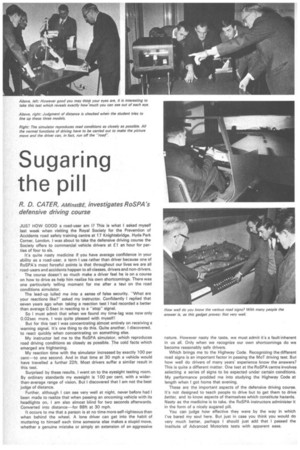Sugaring the pill
Page 60

Page 61

If you've noticed an error in this article please click here to report it so we can fix it.
R. D. CATER, AMInstBE, investigates RoSPA 's defensive driving course
JUST HOW GOOD a road-user am I? This is what I asked myself last week when visiting the Royal Society for the Prevention of Accidents road safety training centre at 17 Knightsbridge, Hyde Park Corner, London. I was about to take the defensive driving course the Society offers to commercial vehicle drivers at E1 an hour for parties of four to six.
It's quite nasty medicine if you have average confidence in your ability as a road-user, a term I use rather than driver because one of RoSPA's most forceful points is that throughout our lives we are all road-users and accidents happen to all classes, drivers and non-drivers.
The course doesn't so much make a driver feel he is on a course on how to drive as help him realize his own shortcomings. There was one particularly telling moment for me after a test on the road conditions simulator.
The lead-up lulled me into a sense of false security. "What are your reactions like?" asked my instructor. Confidently I replied that seven years ago when taking a reaction test I had recorded a better than average 0.5sec in reacting to a "stop" signal.
So I must admit that when we found my time-lag was now only 0.02sec more, I was quite pleased with myself!
But for this test I was concentrating almost entirely on receiving a warning signal. It's one thing to do this. Quite another, I discovered, to react quickly when concentrating on something else.
My instructor led me to the RoSPA simulator, which reproduces road driving conditions as closely as possible. The cold facts which emerged are frightening.
My reaction time with the simulator increased by exactly 100 per cent—to one second. And in that time at 30 mph a vehicle would have travelled a further 22ft. Most drivers suffer a similar result in this test.
Surprised by these results, I went on to the eyesight testing room. By ordinary standards my eyesight is 100 per cent, with a widerthan-average range of vision. But I discovered that I am not the best judge of distance.
Further, although I can see very well at night, never before had I been made to realize that when passing an oncoming vehicle with its headlights on, I am also almost blind for two seconds afterwards. Converted into distance—for 88ft at 30 mph.
It occurs to me that a person is at no time more self-righteous than when behind the wheel. A lone driver can get into the habit of muttering to himself each time someone else makes a stupid move, whether a genuine mistake or simply an extension of an aggressive nature. However nasty the taste, we must admit it's a fault inherent in us all. Only when we recognize our own shortcomings do we become reasonably safe drivers.
Which brings me to the Highway Code. Recognizing the different road signs is an important factor in passing the MoT driving test. But how well do drivers of many years' experience know the answers? This is quite a different matter. One test at the RoSPA centre involves selecting a series of signs to be expected under certain conditions. My performance prodded me into studying the Highway Code at length when I got home that evening.
These are the important aspects of the defensive driving course. It's not designed to teach people to drive but to get them to drive better, and to know aspects of themselves which constitute hazards. Nasty as the medicine is to take, the RoSPA instructors administer it in the form of a nicely sugared pill.
You can judge how effective they were by the way in which I've bared my soul here. But just in case you think you would do very much better, perhaps I should just add that I passed the Institute of Advanced Motorists tests with apparent ease.
Land-Rovers turn up in places ;where a car would be seen dead. They're still running when cars have exhausted their last exhaust. But they also do things that cars can do, just as well.
Things like motoring all day on motorways at a steady 70 mph. And with a choice of fouror six-cylinder petrol engines, or a four-cylinder diesel engine. No car offers this kind of choice.
in our Station Wagon you can sit twelve people on cushioned seats, while their feet sit on fitted rubber matting.
Every day of the week you can use a Land-Rover. Not just for pulling caravans or boats, or any other tough job. They're great for eating picnics in, They're great for week-end family gadabouts. And think how much shopping will go in the boot!
For free information about the "2-in4" Land-Rover, see one of our dealers. Or write to us: Sales Division, The Rover Company Limited, Solihull, Warwickshire.




















































































































